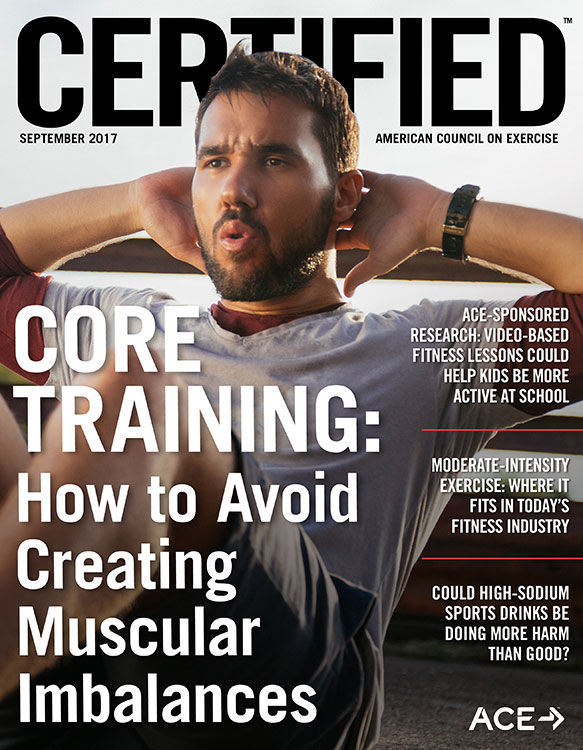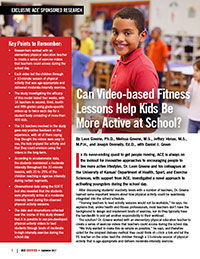
Leon Greene, Ph.D., Melissa Greene, M.S., Jeffery Honas, M.S., M.P.H., and Joseph Donnelly, Ed.D., with Daniel J. Green
In its never-ending quest to get people moving, ACE is always on the lookout for innovative approaches to encouraging people to live more active lifestyles. Dr. Leon Greene and his colleagues at the University of Kansas’ Department of Health, Sport, and Exercise Sciences, with support from ACE, investigated a novel approach to activating youngsters during the school day.
After discussing students’ inactivity levels with a number of teachers, Dr. Greene learned some important lessons about how physical activity could be seamlessly integrated into the school schedule.
“Training teachers to lead activity sessions would not be workable,” he says. He explains that, unlike health and fitness professionals, most teachers don’t have the background to design and implement bouts of exercise, nor do they typically have the bandwidth to add yet another responsibility to their workload.
The solution? Dr. Greene worked with an elementary physical education teacher to create a series of exercise videos that teachers could access during the school day.
“We truly wanted to make this as simple as possible,” he says, and therefore opted for the simplest delivery method they could think of—click a link and let the PE teacher on the video lead the children through a 10-minute session of physical activity that is age-appropriate and delivers moderate-intensity exercise.
The study investigating the efficacy of this model lasted four weeks, with 16 teachers in 2nd, 3rd, 4th and 5th grades using grade-specific videos up to twice each day for a student body consisting of more than 400 kids.
About the Videos
The researchers created eight videos, two for each grade level. The intention was to provide moderate-to-high intensity workouts that are taught in an age-appropriate way, which is why Dr. Greene felt it was so important to enlist the help of elementary PE teacher with experience in leading this age group through exercise sessions.
The following is a quick summary of a couple of the videos to provide an idea of what exercises are featured. As you will see, the fifth-grade video is considerably more intense than the one designed for second graders.
- Second grade:
- Standing: Side steps, front and back steps, walking in place and in a circle, jogging in place, running in place, toe touches, windmill toe touches, alternating knee to chest
- Supine: Bicycle riding slowly, then faster
- Standing: Walking in place, walking with big steps, walking with small steps, deep breathing while bringing arms overhead, single-leg balance, half-squats
- Fifth grade:
- Standing: Toe raises, toe raises with overhead reach, squats, skier jumps, scissor jumps, walking in place, toe touches, jogging in place, walking in place, running in place, sprinting in place, walking in place, windmill toe touches, side-to-side jumping, walking in place
- Using chair: Sit and stands, add jumps, add jumping jacks
- Standing: Walking in place, deep breathing while bringing arms overhead, stork stand, hip twists
Dr. Greene, who observed many of the workouts, reports that the children were very engaged and enjoyed themselves. The teachers were encouraged to participate alongside the children and had a lot of fun as well.
Importantly, there is a misconception that adding exercise to children’s days will just make them more hyper. Dr. Greene reports just the opposite, as the kids tended to return to their desks very quickly after the videos ended and seemed to go right back to what they were working on beforehand.
Teacher Feedback
The 16 teachers involved in this study were asked to complete a simple seven-question survey at the conclusion. Here are the results:
- All 16 teachers thought it was easy to administer the physical-activity sessions.
- None of the teachers thought it was a burden to set up the sessions and have their classes participate.
- All but one of the teachers felt that classroom behavior improved after the sessions.
- None of the teachers found the sessions to be disruptive to class.
- All 16 teachers enjoyed having their class participate.
- All 16 teachers reported that the students enjoyed participating as well.
- All 16 teachers could envision continuing using the videos over the long-term.
The teachers did offer a few recommendations to improve the program. Seven teachers felt that the availability of five-minute videos would be helpful, as there was not always time for the full 10-minute workout. Some teachers reported they would use five-minute videos more often, while others mentioned that longer videos might be useful during indoor recess. A few teachers also noted that background music would be a nice addition.
Exercise Intensity
The researchers used two methods to determine exercise intensity. The first was through the use of accelerometers, which are motion sensors that detect accelerations of the body. The intensity of physical activity can then be assessed as a function of body movement.
Table 1 presents the accelerometer data for grades 2 through 4 (fifth graders did not use the accelerometers because the teachers did not think it was feasible for the students to take the time to put them on their waists). Note that it was not possible for all classes to complete two sessions every day due to time constraints. What the data in Table 1 show is that the students maintained a moderate intensity throughout the 10-minute lessons, with 20 to 25% of the children reaching a vigorous intensity during certain segments.
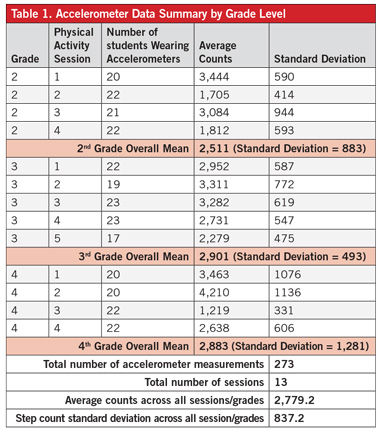
The second means of determining exercise intensity was through the use of the System for Observing Fitness Instruction Time (SOFIT). The SOFIT tool assesses physical education by enabling the researcher to collect data on student activity levels, lesson context and teacher behavior. The researchers randomly selected classrooms and individual students to observe, with each grade and classroom being represented over the course of the four weeks. The process involves grading the person’s activity level on a scale of 1 to 5 each minute. Table 2 presents the SOFIT scores for all grades, which reveal that the students were physically active at a moderate intensity level during the observed physical-activity sessions.
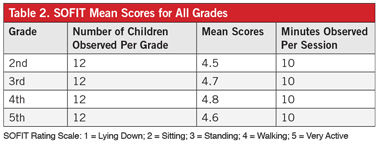
Interestingly, the SOFIT scores for the teachers were almost equal to those of the students, with scores ranging from 4.1 to 4.3.
In terms of the amount of physical activity performed each day, 2nd graders averaged 16 minutes per day, 3rd graders averaged 12.8 minutes, 4th graders averaged 17.1 minutes and 5th graders averaged 15.2 minutes.
The Bottom Line
The data and observations collected over the course of this study showed that it is possible to use pre-developed physical-activity videos to lead students through bouts of moderate-to-high intensity exercise during the school day. The importance of this cannot be overstated, as compensating for the increasing absence of physical education in schools is vital to the health and fitness of future generations.
So, what does this mean to health and fitness professionals? The findings from this study affirm the effectiveness of the remote delivery of fitness videos for a specific audience. If you are able to create short-duration, moderate-intensity content that is deliverable through video, Skype, Facetime or other online means, you may be able to reach new audiences and expand your client base.
“The key,” says Dr. Greene, “is to deliver content in a way that is appropriate to the target audience in terms of intensity, duration and skill level, as well as in terms of the language and tone of voice used to address viewers.”
Further Your Knowledge
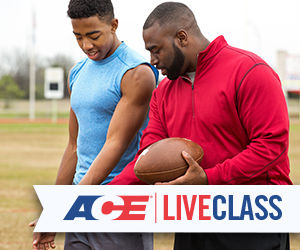
If you’re interested in learning more about youth fitness, check out Training Youth Athletes, which was recorded live and features ACE Certified Personal Trainer Melissa Myers, M.S. You’ll learn about considerations for training multidirectional youth athletes and how to develop a training program for youth athletes that addresses both long- and short-term goals. Also covered is specific programming for developing strength, power, speed and endurance in youth athletes.
Why Does ACE Sponsor Fitness-related Research Studies?
This study was sponsored by the American Council on Exercise. For more than 20 years, ACE has commissioned independent research studies from major universities and trusted partners across the country, covering everything from infomercial fitness products to the effectiveness of some of the hottest trends in health and fitness. ACE is committed to investing in these studies as part of its mission to promote the benefits of physical activity and to protect people from unsafe and ineffective fitness products and trends. You can find more information about past ACE-sponsored studies, including research on the best abdominal exercises, kettlebell workouts and Zumba, by clicking here.





 by
by 